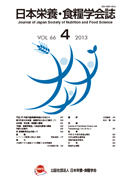All issues

Volume 66 (2013)
- Issue 6 Pages 279-
- Issue 5 Pages 241-
- Issue 4 Pages 177-
- Issue 3 Pages 127-
- Issue 2 Pages 69-
- Issue 1 Pages 3-
Predecessor
Volume 66, Issue 4
Displaying 1-2 of 2 articles from this issue
- |<
- <
- 1
- >
- >|
Review
-
Tatsuya Sugawara2013 Volume 66 Issue 4 Pages 177-183
Published: 2013
Released on J-STAGE: August 16, 2013
JOURNAL FREE ACCESSSphingolipids are ubiquitous components of the cell membrane in all eukaryotic organisms, and are involved with differentiation and apoptosis. Recently, various physiological functions of dietary sphingolipids, especially the improvement of skin barrier function, have been noted. In order to understand the function of dietary sphingolipids, details of their digestion and absorption need to be clarified. Dietary sphingolipids such as glucosylceramide and sphingomyelin can be hydrolyzed to sphingoid bases, which are then taken up by intestinal mucosal cells. However, the capacity of the intestine for digestion and absorption of sphingolipids is relatively low. Sphingoid bases, except for sphingosine, appear to be transported out of cells across the apical membranes of enterocytes by P-glycoprotein after absorption, and consequently their intestinal uptake is poor. To utilize sphingolipids effectively as food functional components, further study of the mechanism of their selective absorption will be necessary.View full abstractDownload PDF (799K)
Original Paper
-
Mariko Nakamoto, Tohru Sakai, Emi Shuto, Nanako Aki, Chisato Kosugi, A ...2013 Volume 66 Issue 4 Pages 185-193
Published: 2013
Released on J-STAGE: August 16, 2013
JOURNAL FREE ACCESSThe aim of this study was to examine the association between the period between dinner and bedtime, and various adult lifestyle-related diseases in the workplace. We analyzed 470 men and 252 women aged 20-65 years who had been enrolled in baseline surveys conducted for the Tokushima Diabetes Cohort Study in a workplace setting in Tokushima prefecture. Multiple logistic regression models were used for analyzing the association of the time between dinner and bedtime and the prevalence rates of adult lifestyle-related diseases. The period between dinner and bedtime tended to show an inverse dose-response relationship with hypertension (p for trend = 0.04) after adjustment for age, sex and other potential confounders. The group with the longest period between dinner and bedtime had an adjusted odds ratio of 0.38 (95% confidence interval 0.17-0.82) compared to the reference group (first quartile group) . Additionally, the period between dinner and bedtime showed an inverse dose-response relationship with hypertension for subjects who ate dinner after 21:00 (p for trend = 0.02) . These results indicate that the period between dinner and bedtime is inversely associated with the prevalence of hypertension.View full abstractDownload PDF (765K)
- |<
- <
- 1
- >
- >|